“Global Autonomous Driving Software Market to reach a market value of USD 4.3 Billion by 2031 growing at a CAGR of 13.3%”
The Global Autonomous Driving Software Market size is expected to reach $4.3 billion by 2031, rising at a market growth of 13.3% CAGR during the forecast period.
As autonomous vehicles become more prevalent, consumer interest and demand for these technologies increase. The desire for improved safety, convenience, and efficiency in transportation drives the adoption of this software. The expansion of autonomous vehicle fleets, including ride-hailing services and delivery vehicles, creates a growing market for autonomous driving software. Fleet operators require advanced software solutions to manage and optimize their operations. Therefore, the Vehicle Type Segment captured a $1.6 Billion revenue in 2023.
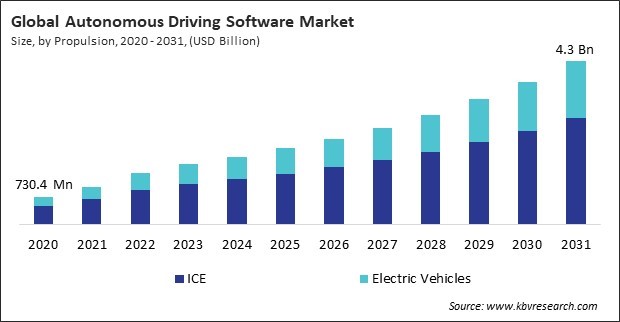
The major strategies followed by the market participants are Product Launches as the key developmental strategy to keep pace with the changing demands of end users. For instance, In April, 2024, Huawei Technologies Co., Ltd. unveiled its new software brand Qiankun on Wednesday, aiming to boost its presence in the electric vehicle sector. Qiankun, named after heaven and the Kunlun Mountains, will offer self-driving systems encompassing driving chassis, audio, and driver's seat, according to Jin Yuzhi, CEO of Huawei's IAS unit. Moreover, In January, 2024, Intel Corporation unveiled new automotive AI chips, competing with NVIDIA and Qualcomm. To bolster its position, Intel acquired the French startup Silicon Mobility, known for its SoC technology for electric vehicles and in-car systems. Intel's new automotive chips will adapt its AI PC tech to meet vehicle performance needs.
Based on the Analysis presented in the KBV Cardinal matrix; NVIDIA Corporation is the forerunner in the Autonomous Driving Software Market. In June, 2024, NVIDIA Corporation unveiled the Omniverse Cloud Sensor RTX at the Computer Vision and Pattern Recognition conference. This new AI simulation software blends real and synthetic sensor data, enabling developers to test and refine sensor perception and AI software in realistic virtual settings, aiming to boost safety, cut costs, and speed up development. Companies such as Huawei Technologies Co., Ltd., Qualcomm Incorporated, and Mercedes-Benz Group AG are some of the key innovators in Autonomous Driving Software Market.
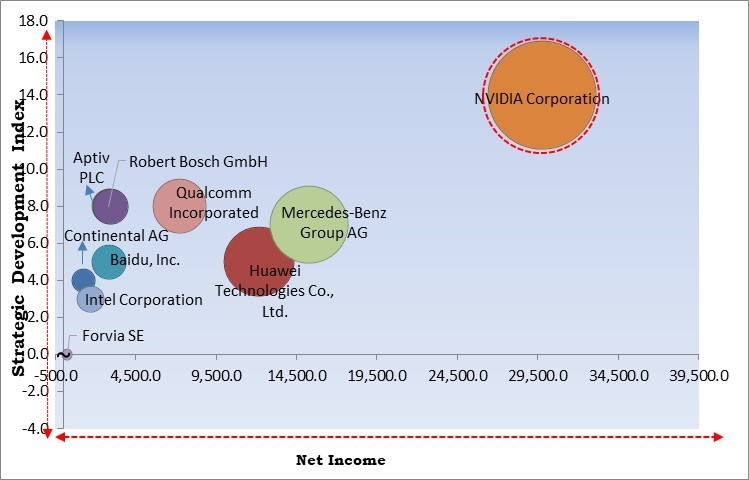
Advances in computer vision algorithms allow for more accurate detection and classification of objects, such as vehicles, pedestrians, and road signs. Enhanced algorithms enable autonomous vehicles to understand their environment better and make safer driving decisions. Modern computer vision systems process visual data in real time, enabling immediate response to dynamic changes in the driving environment, such as sudden obstacles or traffic signal changes. In conclusion, computer vision and sensor fusion advancements are driving the market's growth.
Additionally, 5G networks provide ultra-low latency, meaning there is minimal delay in data transmission. This is critical for autonomous vehicles, which must instantly process and respond to data from their surroundings. For instance, detecting a sudden obstacle and making a quick maneuver requires real-time communication to ensure safety and efficiency. Therefore, the expansion of 5G and connectivity infrastructure propels the market's growth.
Developing this software requires cutting-edge technology, including sophisticated algorithms, high-performance computing hardware, and advanced sensors like LiDAR, radar, and cameras. The initial research and development (R&D) costs of these technologies are substantial. Developing autonomous driving systems involves long research, testing, and iteration cycles. Thus, high development and implementation costs are impeding the market's growth.
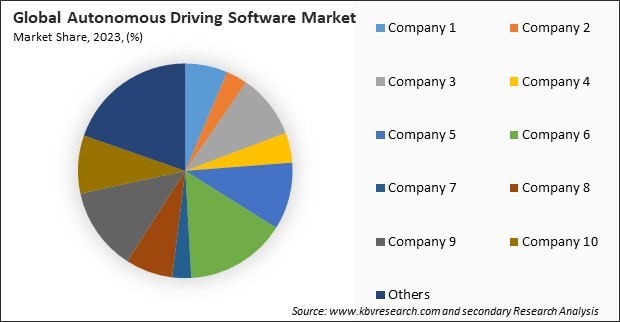
The leading players in the market are competing with diverse innovative offerings to remain competitive in the market. The above illustration shows the percentage of revenue shared by some of the leading companies in the market. The leading players of the market are adopting various strategies in order to cater demand coming from the different industries. The key developmental strategies in the market are Product Launches and Product Expansions.
Based on propulsion, this software market is categorized into ICE and electric vehicles. The electric vehicles segment witnessed 32% revenue share in this software market in 2023. EVs are often built with more advanced electronic architectures, making integrating ADS easier. The software systems in EVs are designed to handle complex tasks, facilitating the addition of autonomous features. EVs have simpler mechanical systems than internal combustion engine (ICE) vehicles, reducing the complexity of integrating autonomous software.
On the basis of level of autonomy, this software market is segmented into L1, L2, L3, and L4 & L5. In 2023, the L4 & L5 segment attained 8% revenue share in this software market. L4 and L5 systems aim to eliminate human error, a significant cause of accidents. By removing the human driver from the equation, these systems promise a significant increase in road safety. Autonomous vehicles can optimize traffic flow and reduce congestion through better coordination and communication with each other and traffic infrastructure.
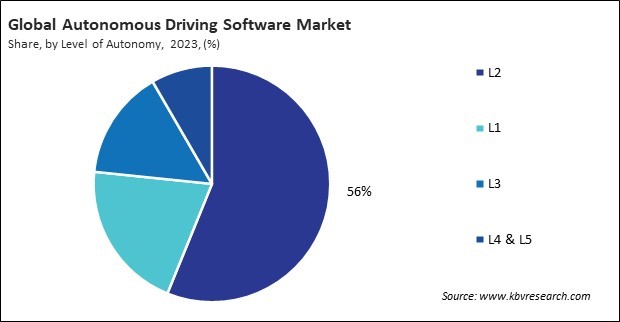
Based on vehicle type, this software market is divided into passenger vehicle and commercial vehicle. The commercial vehicle segment attained 30% revenue share in the autonomous driving software market in 2023. ADS in commercial vehicles can optimize routes to reduce fuel consumption, travel time, and maintenance costs. Sophisticated algorithms analyze traffic patterns, weather conditions, and road types to find the most efficient routes.
This software market is divided by software type into perception & planning software, chauffeur software, interior sensing software, and supervision & monitoring software. The interior sensing software segment procured 20% revenue share in this software market in 2023. Interior sensing ensures a seamless transition between human and autonomous control. For instance, the system can verify that the driver is prepared to take over when transitioning from autonomous to manual driving. In fully autonomous vehicles (Level 4 and 5), interior sensing can monitor passenger behavior, detect emergencies, and provide appropriate responses, ensuring passenger safety even without a human driver.
Free Valuable Insights: Global Autonomous Driving Software Market size to reach USD 4.3 Billion by 2031
Region-wise, this software market is analyzed across North America, Europe, Asia Pacific, and LAMEA. The Europe region generated 31% revenue share in the autonomous driving software market in 2023. Europe has some of the world's most stringent vehicle safety regulations, which drive the development and integration of advanced autonomous systems to meet these high standards. European Union policies are increasingly supportive of autonomous driving technology. Initiatives such as the EU’s “Roadmap for Connected and Automated Mobility” aim to facilitate the deployment of ADS and ensure regulatory frameworks keep pace with technological advancements.
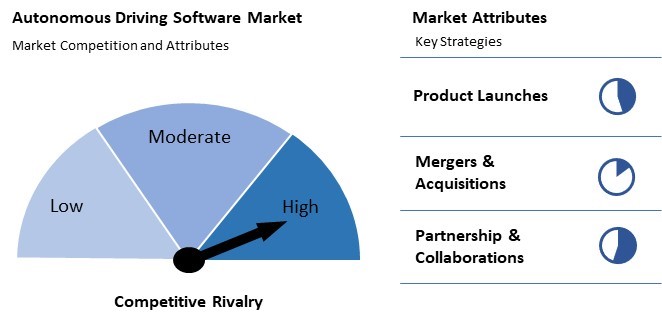
The competition in the Autonomous Driving Software Market is intense, driven by advancements in artificial intelligence, machine learning, and sensor technology. Companies focus on developing robust algorithms for real-time decision-making, enhancing vehicle safety, and improving scalability. Collaboration with automakers and regulatory compliance play crucial roles in gaining market share.
| Report Attribute | Details |
|---|---|
| Market size value in 2023 | USD 1.6 Billion |
| Market size forecast in 2031 | USD 4.3 Billion |
| Base Year | 2023 |
| Historical Period | 2020 to 2022 |
| Forecast Period | 2024 to 2031 |
| Revenue Growth Rate | CAGR of 13.3% from 2024 to 2031 |
| Number of Pages | 300 |
| Number of Tables | 443 |
| Report coverage | Market Trends, Revenue Estimation and Forecast, Segmentation Analysis, Regional and Country Breakdown, Competitive Landscape, Market Share Analysis, Porter’s 5 Forces Analysis, Company Profiling, Companies Strategic Developments, SWOT Analysis, Winning Imperatives |
| Segments covered | Propulsion, Level of Autonomy, Vehicle Type, Type, Region |
| Country scope |
|
| Companies Included | Aptiv PLC, Baidu, Inc., Continental AG, Huawei Technologies Co., Ltd. (Huawei Investment & Holding Co., Ltd.), Intel Corporation, NVIDIA Corporation, Forvia SE, Qualcomm Incorporated (Qualcomm Technologies, Inc.), Robert Bosch GmbH, and Mercedes-Benz Group AG |
By Propulsion
By Level of Autonomy
By Vehicle Type
By Type
By Geography
This Market size is expected to reach $4.3 billion by 2031.
Advancements In Computer Vision And Sensor Fusion are driving the Market in coming years, however, High Development And Implementation Costs restraints the growth of the Market.
Aptiv PLC, Baidu, Inc., Continental AG, Huawei Technologies Co., Ltd. (Huawei Investment & Holding Co., Ltd.), Intel Corporation, NVIDIA Corporation, Forvia SE, Qualcomm Incorporated (Qualcomm Technologies, Inc.), Robert Bosch GmbH, and Mercedes-Benz Group AG
The expected CAGR of this Market is 13.3% from 2024 to 2031.
The ICE segment led the Market by Propulsion in 2023; thereby, achieving a market value of $2.8 Billion by 2031.
The North America region dominated the Market by Region in 2023, and would continue to be a dominant market till 2031; thereby, achieving a market value of $1.5 Billion by 2031.
Our team of dedicated experts can provide you with attractive expansion opportunities for your business.

 Drivers
Drivers
 Restraints
Restraints
 Opportunities
Opportunities
 Challenges
Challenges
